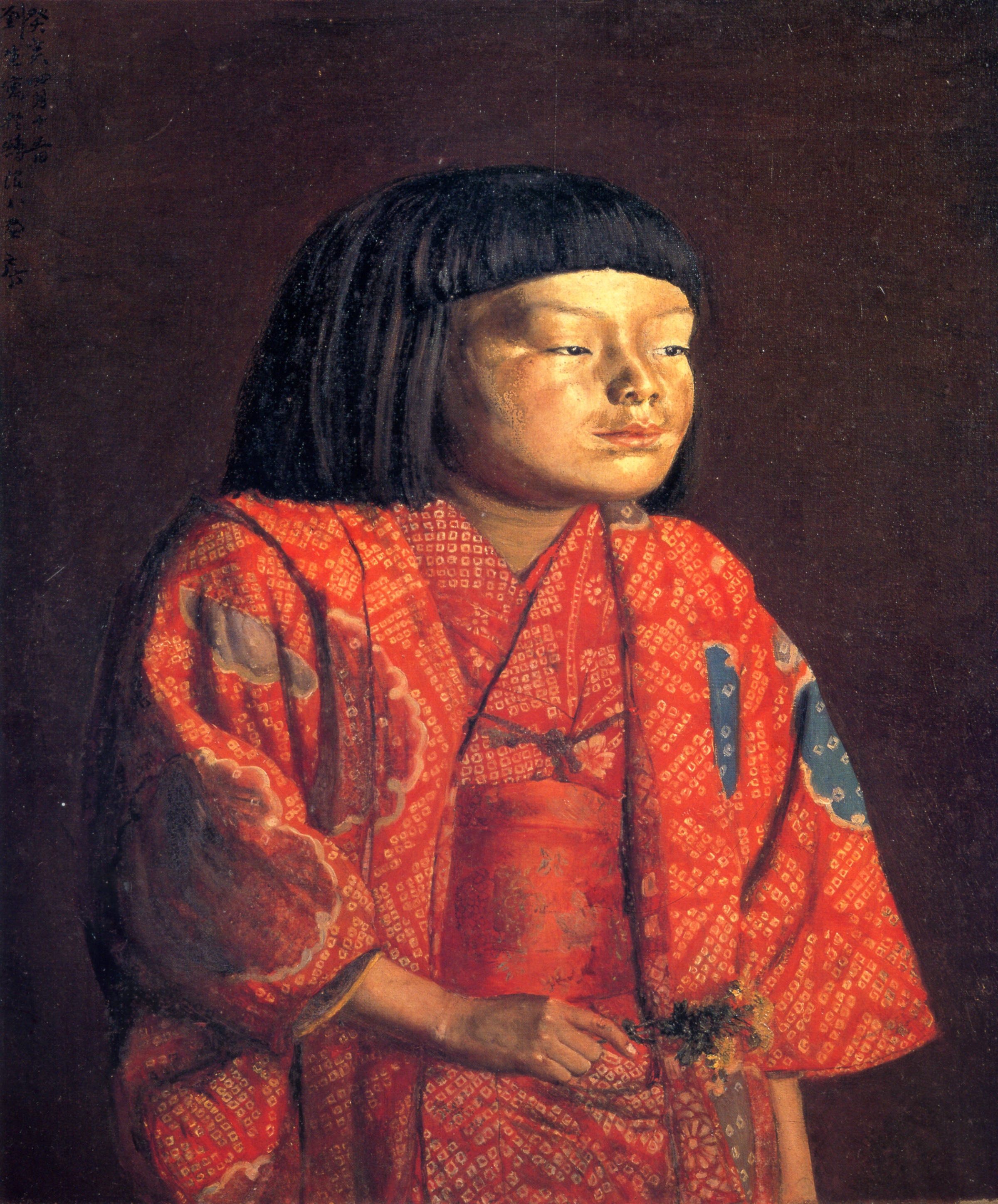- Ryūsei Kishida
Infobox Artist
name = Ryūsei Kishida

imagesize = 200px
caption = Ryūsei Kishida
birthname =
birthdate =23 June 1891
location =Tokyo ,Japan
deathdate =20 December 1929
deathplace =Tokuyama, Yamaguchi
nationality = Japanese
field = Painter
training =
movement = Yōga
works =
patrons =
awards = nihongo|Ryūsei Kishida|岸田劉生|Kishida Ryūsei; (23 June 1891 –20 December 1929 ) was a Japanese painter in Taishō andShōwa period Japan . He is best-known for his realistic yōga-styleportraiture , but also for his "nihonga " paintings in the 1920s.Biography
Kishida was born in the
Ginza district ofTokyo in 1891 as the son ofKishida Ginko , a noted journalist who once assistedJames Curtis Hepburn compile his Japanese-English dictionary. Kishida left school in 1908 to study Western-style art underKuroda Seiki at his "Hakubakai" studio. He began exhibiting his works at the government’s annual "Bunten" exhibition from 1910.While his earliest works reflect the
plein-air style promoted by Kuroda, Kishida later became close friends withSaneatsu Mushanokōji and his "Shirakaba " (White Birch Society), through which he was introduced tofauvism andcubism . He formed his own artistic circle called "Fyuzankai" (Fusain Society) in 1912 to help promote the styles ofhumanism andpost-impressionism . The group soon collapsed due to internal conflicts after holding two exhibitions, but Kishida created another circle called "Sōdōsha" in 1915. [Burghaus, "International Futurism in Arts and Literature". Page 251 ]From around 1917, Kishida relocated his residence to Kugenuma in
Fujisawa, Kanagawa , near the summer home of his friend Mushanokōji. He also began to incorporate the techniques of northern EuropeanRenaissance artists such asAlbrecht Dürer and Van Dyke into realistic portraiture, but did not directly copy their styles. During this period, he painted his famous series of paintings of his daughter Reiko, which combine photographic realism with almost surreal decorative elements, which exhibit the tension between expressionism and technique. His famous "Kiritoshi no Shasei", also painted near this time realistically depicts a path through a hill. However, it is not an actual path that Kishida viewed and painted, but is a “universal scene” which could be set anywhere in the world, at any point in time. [Kato, Shuichi, "Japan:Spirit and Form". Page 248 ] Infobox Painting|
title= Young Girl Standing
artist=Kishida Ryūsei
year=1923
type=Oil on wood
height=52
width=44
height_inch=
width_inch =
city=Hayama, Kanagawa
museum=Kanagawa Prefectural Museum of Modern Art In the early 1920s, Kishida suddenly did a volte-face and abandoned yōga painting for "nihonga " , incorporating elements from eastern art, in particularChinese paintings of the Song and Yuan dynasties, as well as early "ukiyo-e " woodblock prints. His home in Kugenuma was destroyed by theGreat Kanto Earthquake of 1923, and he moved toKyoto for a brief periond before returning to Kamakura. In the 1920s, he came to be noted as an art historian as well as a painter, writing numerous articles on traditional Japanese painters. [Kita, "The Last Tosa". page.57 ]In 1929, sponsored by the
South Manchuria Railway Company , Kishida made his one and only overseas trip, visitingDalian ,Fengtian andHarbin inManchuria . Almost immediately after his return from this trip, he moved from Kamakura toTokuyama, Yamaguchi , where he died ofuremia at the young age of 38. His grave is at the Tama Reien Cemetery inFuchū, Tokyo .In December 2000, one of Kishida’s "Portrait of Reiko" was sold for 7.731 billion
Yen , the highest price ever achieved for a Japanese painting. [Goodwin, "The International Art markets". Page. 213 ]References
* Berghaus, Günter. "International Futurism in Arts and Literature". Walter de Gruyter (2000) ISBN 3110156814
*Goodwin, James. "The International Art Markets: The Essential Guide for Collectors and Investors". Kogan Page (2008). ISBN 0749448350
*Kato, Shuichi, "Japan:Spirit and Form". Tuttle Publishing (1994) ISBN 0804819696
*Kita, Sandy. "The Last Tosa: Iwasa Katsumochi Matabei, Bridge to Ukiyo-e". University of Hawaii Press, (1999) ISBN 0824818261
*Kitazaki, Noriaki. "Kishida Ryusei to Taisho avangyarudo". Iwanami Shoten (1993) ISBN 4000037285
*Weisenfeld, Gennifer, "MAVO: Japanese Artists and the Avant-Garde, 1905–1931". University of California Press (2001). ISBN 0520223381External links
* [http://search-art.aac.pref.aichi.jp/p/seisaku.php?AI=ART19970287 Aichi Prefectural Art Museum]
* [http://www.menard.co.jp/museum/english_french/collection/japanese-w_kishida.htm Kishida Rusei at Menard Museum of Art]
* [http://www.pref.mie.jp/bijutsu/hp/collection/works/kishida_e.htm Mie Prefectural Museum]
* [http://www.pref.miyagi.jp/bijyutu/mmoa/en/navigation/index.asp?url=../museum/collect002.html Miyagi Prefectural Museum of Art]
* [http://www.tnm.go.jp/en/servlet/Con?pageId=D01&processId=01&colid=A10568 Tokyo National Museum]Notes
Wikimedia Foundation. 2010.
